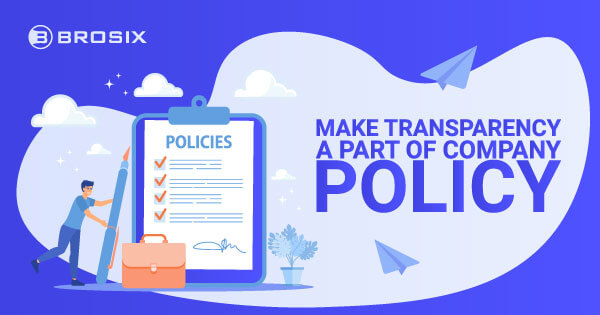Does your organization communicate transparently?
When many companies start working on enhancing communication and collaboration in the workforce, they focus on core concepts like speed, simplicity and convenience. However, it’s important not to overlook the importance of transparency in communication too.
After all, transparency is one of the cornerstones of trust. In order for employees to believe in the companies they work with, feel invested in their team, and connect with their leaders, they need to believe they’re getting all of the information they need.
In fact, studies show that 46% of employees say a lack of transparent communication from leadership is the top reason why they start looking for a new role. What’s more, 70% of employees say they’re more engaged in their job when the company invests in transparent communication.
Transparent communication fosters a collaborative culture, where everyone has a voice, and secrets are abolished in favor of honesty and openness.
What is Transparency in Communication?
So, what is transparency in communication?
According to Michigan State University, transparent communication is a style of interaction wherein both positive and negative information is openly shared in a lateral, upward and downward manner. In other words, rather than just sharing some details with certain people in an organization, business leaders ensure everyone has access to the same knowledge.
Transparent companies consistently disclose valuable information to their employees, regardless of whether it’s positive or negative. Additionally, they ensure everyone can participate in the growth and development of the business, by keeping all staff members on the same page.
Simply put, transparent communication promotes two-way conversations between employees and management. Employees can share feedback and insights to leaders on how to improve the workplace, and leaders ensure their team members aren’t kept in the dark about business changes.
A transparent workplace nurtures an environment where employees feel comfortable and stable. Every team member can be open about their achievements and mistakes, which leads to better growth. Additionally, everyone can benefit from valuable feedback.
The Benefits of Preserving Transparency in Business Communication
Most companies know good communication is the key to running a successful workplace. Whether your employees are in-house or working remotely, they need to be able to communicate freely to collaborate, minimize mistakes and generate results.
Transparency in communication creates an environment primed for success, allowing for better relationships between team members, enhanced loyalty and improved trust. According to one survey, transparency in communication is also one of the top factors contributing to employee happiness.
When companies invest in transparent communication, they benefit from:
- Trust and loyalty: If everyone is informed about the business, and feels confident sharing information with others, this leads to better trust and relationships among teammates. Building a culture around transparency fosters authentic, honest connections.
- Increased productivity: Employees need access to the right information to produce their best work. Open communication and free knowledge sharing significantly reduces productivity issues and helps everyone to operate more effectively. Additionally, transparency boosts engagement, which also translates to a better flow of work.
- Streamlined organizational change: All companies are subject to change over time, but alterations to the status quo can often lead to disruptions in companies that aren’t transparent. Research shows that transparency helps people to accept and cope with organizational changes more readily, minimizing issues.
- Better retention: When employees build better relationships with their peers and managers, and feel more engaged in the workplace, they’re more likely to stick around. This is particularly important in a time of rapid transformation, when access to talent is dropping, and turnover is becoming a core problem for businesses.
- Greater agility: Transparency in communication means everyone in the business can share input and ideas on a consistent basis. This leads not only to greater innovation, but better agility among companies dealing with sudden challenges and problems.
Problems Caused by a Lack of Transparency in Communication
While championing transparency in communication leads to a number of organizational benefits, failing to support transparency can bring a host of problems. Fundamentally, when knowledge can’t flow freely throughout the workplace, company culture is stunted.
Lack of transparency in the workplace can lead to disengagement, rapid talent turnover and reduced employee satisfaction. At the same time, it also means business leaders are more likely to start micromanaging, as they’re the only people with the right information to ensure tasks are completed properly. Micromanaging harms employee morale, and reduces opportunities for creativity. Around 55% of employees say micromanagement from leaders negatively affects their productivity.
A lack of transparent communication channels often means people turn to gossip for information sharing, which leads to miscommunication and troubled relationships. Additionally, some companies may even find their employees start hiding their mistakes, due to fear about where honesty might lead them. Hidden mistakes take longer to rectify and can snowball into bigger problems.
How to Enhance Communication and Transparency in the Workplace
The good news for business leaders is there are various ways to encourage transparency in communication throughout the workplace. For the most part, the best strategies involve a combination of implementing the correct policies, and using the right technology.
Here are some of the best methods for fostering transparency in communication.
1. Make Transparency a Part of Company Policy
Transparency in the workplace thrives when it becomes a core part of company culture. As soon as new employees are brought into the workplace, they should see examples of transparency being demonstrated by leaders. Managers should consistently own up to their mistakes, share their thoughts and encourage others to take part in business communication.
Additionally, employees should be encouraged to maintain transparency at all times. This means leaders may have to change the way they respond to information and feedback. An employee who shares negative thoughts about the business shouldn’t be punished. All feedback, good and bad, should be handled with the same degree of respect and care.
2. Confront Difficult Situations as a Team
Any business will encounter problems at some point. Whether it’s an issue with an important client, a regulatory problem or a loss of funding. Addressing these problems with your team can be a nerve-wracking concept, as you may worry your employees will panic or jump ship at the first sign of turmoil. However, approaching problems as a team helps to cultivate collaborative work.
When leaders encounter issues, they should share them with their team in a clear, authentic manner, along with their own ideas about how they can overcome the problem. They should be open to answering questions employees might have and crowdsourcing solutions. This approach to problem solving also makes employees feel like they’re a more vital part of the business.
3. Use Technology to Your Advantage
Transparency can’t thrive in a business unless employees have access to clear lines of communication. In today’s complex business environment, it’s important for business leaders to ensure they have communication tools in place which enable everyone to have a voice. This means choosing tools that align remote, hybrid, and in-office workers.
Instant messaging apps like Brosix are one of the best solutions for fostering transparent communication. Brosix ensures every member of your team can take part in secure, effortless conversations. You can design dedicated chat rooms for specific groups, and provide your staff with access to a host of helpful tools for productivity and task management, such as screen sharing and whiteboarding.
4. Host Regular Meetings
While instant messaging solutions are ideal for encouraging rapid, consistent communication, there are moments when you need a more intimate, face-to-face interaction with your employees. In these instances, choosing a tool with a built-in video conferencing solution for communication is invaluable. The software ensures everyone can connect in a humanized environment, for important discussions, without the need for travel.
Meetings don’t have to have a strict purpose to be valuable. Although it’s important to host conferences about updates and news alerts, it might also be worthwhile to invite everyone in your team along for regular catch-up sessions and discussions. Teams could even use weekly meetings to report on their goals, challenges and accomplishments.
5. Avoid Complicated Jargon
One of the biggest mistakes business leaders make when attempting to nurture transparency in the workplace, is communicating the right information in the wrong language. For instance, if you’re having a meeting about marketing campaigns, you might use terms like ROI and SEO that would make sense to the marketing team, but fly over the heads of other professionals.
Explaining terms and making sure everyone can understand the contents of the discussion is crucial. Before you start a meeting or conversation, think about how you can adjust your language to appeal to everyone in your organization. It’s also worth making sure your employees can raise their hands and ask questions comfortably about anything they don’t understand.
6. Share Updates in Real-Time
Waiting too long to share relevant information in a team environment is another area where companies can struggle with transparency. Ultimately, people don’t want to hear about changes to the business or important topics through the grapevine. They want to see evidence that their leadership team is committed to keeping them up to date.
A communication platform which allows you to send instant broadcasts to everyone about important topics can be a great way to keep gossiping and rumors to a minimum. Even a simple broadcast such as “Our collaboration plan is changing, we’ll be meeting at [time] to discuss” can stop employees from panicking, and ensure everyone feels informed.
7. Make Information Accessible
Within any organization, there is a lot of information employees need to be able to access at any time, not just about products and services, but also about customers, values, visions, missions and plans. For a company to be transparent, it should ensure all of this information is easily accessible. Creating a knowledgebase full of valuable company information can be helpful here.
In the knowledgebase, you can include access to documented company policies and other important details. You could also create a “news” section on your internal intranet where you provide your employees with information they might have missed during broadcasts and meetings. Even recording meetings for employees to view later can ensure no-one misses out.
8. Explain your “Why”
Leaders in any business make numerous decisions on a daily basis. However, they don’t always explain why they’re choosing certain paths over another. Explaining why certain decisions were made specifically, can help to create an open environment for communication and discussion. It also opens the door for employees to share their own feedback.
Just as it’s important to explain decisions you make, it’s also important to provide employees with an insight into why certain data should be kept private. For instance, if you can’t be transparent about a specific topic, tell your employees why. Let them know if there’s a compliance issue you need to deal with, or why certain data needs to be kept confidential.
9. Celebrate Transparency Daily
Building a transparent company culture doesn’t just mean ensuring leaders and business managers share all the right information with their employees. It also means encouraging every team member to be transparent too. The only way to do this is to reward those who share their thoughts. Encourage employees to share ideas and feedback in any manner they feel comfortable with, and thank them when they get involved.
When an employee admits to a mistake, reward them for being open and honest. If employees deliver feedback and ideas about how to improve the workplace, act on them. You don’t necessarily need to implement all of the suggestions made, but if you don’t want to act on a suggestion, explain why you’re taking a different route.
Embrace Transparency in Communication
Transparency in communication is one of the most valuable things any business can foster. Without transparency, all members of an organization begin to suffer. A lack of transparency breeds distrust, micromanaging behaviors and a lack of engagement. However, when you champion honest and open discussion in your workplace, bonds are formed, loyalty is created and innovation thrives. Don’t just aim for transparency in your business, start taking steps to implement it today. Your employees and the bottom line will thank you.
Thanks to Brosix, nurturing transparency in communication is simple. Not only can you provide your employees with multiple ways to communicate, from chat to video calls, but you can also keep staff up to date with instant business-wide notifications. Plus, with message histories, there’s no chance of any crucial information going missing.









